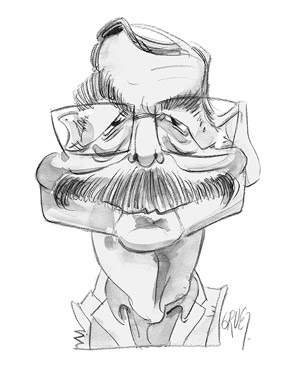
Wolfgang Streeck in Inference:
STRANGE PERSONALITIES arise in the cracks of disintegrating institutions. They are often marked by extravagant dress, inflated rhetoric, and a show of sexual power. The first Trumper of the postwar era was the Danish tax rebel, Mogens Glistrup, the founder of the nationalist Progress Party, who, having put his principles into practice, went to prison for tax evasion. Geert Wilders in the Netherlands and Boris Johnson in England are hairstyle Trumpers. Pim Fortuyn and Jörg Haider were both dandies. They died in their finery. Beppe Grillo, Nigel Farage, and Jean-Marie Le Pen, are each one third of a full Trump.
Trumpers generate their populist charisma among Trumpists by defying convention; they appear extraordinary to those who are intimidated but not impressed by society’s machinery of social control. With hindsight, it seems as though the capitalist democracies have been waiting for their Trumpers, men and women eager to liberate public speech from its commitment to the unbelievable. Donald Trump’s promise to make America great again is an acknowledgement that the United States is a power in decline, embarrassingly unable since Vietnam to win, or even to finish, any of the wars that it started. When Trumpers ask about NATO, they are asking why NATO should continue to exist a quarter century after the end of the Soviet Union. Calls for economic protectionism raise the question, long taboo among liberal internationalists, of whether new free trade agreements are really to everyone’s benefit, and why, in particular, the government of the United States should have let its country deindustrialize. The United States has an elaborate immigration policy, and yet there are eleven million illegal immigrants in its territory. Trumpers say this is odd, and Trumpists agree with them.
In The Eighteenth Brumaire of Louis Bonaparte, Karl Marx recounted the coup d’état of 1851 by which the nephew of Napoleon I, Louis Bonaparte, seized power, ruling France first as its president, and a year later as its emperor. He governed as Napoleon III until 1871, when the Prussian army under Helmuth von Moltke put an end to his administration, along with his amour-propre. Marx described Bonapartism as a popular form of government by personal rule. It arose, he argued, in stalemated European societies, with the capitalist class too divided, and the working class too disorganized, to instruct or inform the government. The result was a degree of relative state autonomy, one expressing, even as it masked, a deadlock between social classes.
Bonapartist politics is driven by the idiosyncrasies of its Bonaparte. This is not a recipe for effective rule. Since a capitalist society under Bonapartism lacks the power to control, or contain, market forces, capitalists can afford to let their Bonaparte stage spectacles of political bravado; behind the scenes, markets do what markets do. In reflecting on the two Napoleons, Marx remarked that the first was a tragedy, but the second, a farce.
More here.
It should go without saying that India is a complicated place, a churning cauldron of languages, ethnicities, castes, and religions bubbling atop and throughout one another in a perplexing mass that we call, for the sake of convenience, a "nation." But to many Western readers, the story of India begins and ends with Gandhi's campaign against the British, followed (for those who were paying attention) by the bloody events of Partition in 1947.
